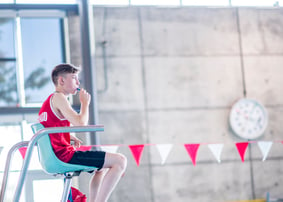When thinking about essential lifeguard equipment, a rescue tube, first aid supplies, and whistle may come to mind. But another very important piece of equipment is the lifeguard stand or platform. A lifeguard platform should provide a clear and unobstructed view of the surface and bottom of the pool. This can be hard to achieve in many pool environments. 
The most critical part of a lifeguard’s job is recognizing and responding to an emergency. According to the American Red Cross lifeguarding guidelines, lifeguards are expected to be able to do this in one to two minutes. This can be a tall order, especially in a crowded and busy pool filled with children. Making sure lifeguards are in the best position to be able to recognize a swimmer in distress is key and lifeguard platforms, when positioned correctly, can help.
Height is an important part of positioning a stand correctly, as higher stands provide more visibility to the bottom of the pool. But height isn’t the only thing that should be taken into consideration. Visual obstructions like slides and diving boards can affect where a platform should be placed. In addition, glare from windows and overhead lighting is essential to consider and the amount of glare can change depending on the season and position of the sun. Overall, the safest placement of a lifeguard platform depends on the unique characteristics of each pool.
If you’re trying to determine the best position for an elevated lifeguard platform, be sure to read through our safety summary “The View from the Stand: Lifeguard Platform Basics.” With much more in-depth information on considerations for platform basics and photo comparisons between different platform heights, it’s an invaluable resource for keeping your pool safe.





